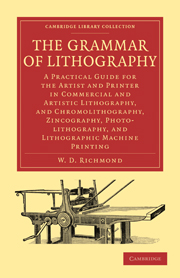 The Grammar of Lithography
The Grammar of Lithography Book contents
- Frontmatter
- Contents
- EDITOR'S INTRODUCTION
- PART I DRAWING, TRANSFERRING AND PRINTING
- CHAPTER I Introductory
- CHAPTER II Mechanical and Chemical Principles of some of the Lithographic Materials used in Printing
- CHAPTER III Instruments, Tools, and Appliances used in Drawing and Writing
- CHAPTER IV Instruments, Tools, and Apparatus used in Printing
- CHAPTER V Accessories to the Lithographic Printing-press
- CHAPTER VI Grinding and Polishing Stones
- CHAPTER VII Lithography on Paper or Transfer Lithography
- CHAPTER VIII Ink Writing and Drawing on Stone
- CHAPTER IX Chalk Drawing on Stone
- CHAPTER X Etching Chalk Drawings on Stone
- CHAPTER XI Taking Impressions for Transferring
- CHAPTER XII Transferring
- CHAPTER XIII Proving and Printing
- CHAPTER XIV Printing (continued)
- CHAPTER XV Printing (continued)
- CHAPTER XVI Miscellaneous Processe
- CHAPTER XVII Miscellaneous Processes (continued)
- CHAPTER XVIII Engraving on Stone
- CHAPTER XIX Zincography
- CHAPTER XX Chromo-lithography
- CHAPTER XXI Chromo-lithography (continued)
- CHAPTER XXII Chromo-lithography (continued)
- CHAPTER XXIII Chromo-lithography (continued)
- CHAPTER XXIV Photo-lithography
- APPENDIX.—Recipes
- PART II LITHOGRAPHIC MACHINE-PRINTING
- BIBLIOGRAPHY OF LITHOGRAPHY
- INDEX
CHAPTER XIII - Proving and Printing
Published online by Cambridge University Press: 05 July 2011
- Frontmatter
- Contents
- EDITOR'S INTRODUCTION
- PART I DRAWING, TRANSFERRING AND PRINTING
- CHAPTER I Introductory
- CHAPTER II Mechanical and Chemical Principles of some of the Lithographic Materials used in Printing
- CHAPTER III Instruments, Tools, and Appliances used in Drawing and Writing
- CHAPTER IV Instruments, Tools, and Apparatus used in Printing
- CHAPTER V Accessories to the Lithographic Printing-press
- CHAPTER VI Grinding and Polishing Stones
- CHAPTER VII Lithography on Paper or Transfer Lithography
- CHAPTER VIII Ink Writing and Drawing on Stone
- CHAPTER IX Chalk Drawing on Stone
- CHAPTER X Etching Chalk Drawings on Stone
- CHAPTER XI Taking Impressions for Transferring
- CHAPTER XII Transferring
- CHAPTER XIII Proving and Printing
- CHAPTER XIV Printing (continued)
- CHAPTER XV Printing (continued)
- CHAPTER XVI Miscellaneous Processe
- CHAPTER XVII Miscellaneous Processes (continued)
- CHAPTER XVIII Engraving on Stone
- CHAPTER XIX Zincography
- CHAPTER XX Chromo-lithography
- CHAPTER XXI Chromo-lithography (continued)
- CHAPTER XXII Chromo-lithography (continued)
- CHAPTER XXIII Chromo-lithography (continued)
- CHAPTER XXIV Photo-lithography
- APPENDIX.—Recipes
- PART II LITHOGRAPHIC MACHINE-PRINTING
- BIBLIOGRAPHY OF LITHOGRAPHY
- INDEX
Summary
Following up what has been explained in previous chapters, we are ready to enter upon the actual printing of drawings and writings on lithographic stones.
113. Treatment of Transfers previous to Printing.—This includes the “proving” of the work: by which is meant the rolling up, cleaning, etching, and taking the first impressions to be submitted to the customer; and the instructions equally apply to drawings or writings executed direct upon the stone.
(a) Suppose the drawing to be composed of very fine lines, the printer may have some doubt as to all the details being firm upon the stone if rolled up in the ordinary way. He may then take, in a sponge, some gum-water (free from acid) of the consistency of oil, and pass it over the entire drawing, using the left hand, while in his right he has a pad of soft rag charged with a mixture of turpentine, thin printing ink, and stone retransfer ink, which may be rubbed over the drawing upon the still wet gum-water, with a circular motion, recharging the pad with ink and the sponge with gum-water as often as necessary. This should develop every line of the drawing, and render it quite black. By keeping sufficient gum upon the stone, there is little fear of injuring the drawing, though it will make the stone very dirty in appearance by reason of the mixture of ink and gum; this, however, may be removed by a wash of clean water, and the stone gummed in with clean gum and set aside for the ink to penetrate.
- Type
- Chapter
- Information
- The Grammar of LithographyA Practical Guide for the Artist and Printer in Commercial and Artistic Lithography, and Chromolithography, Zincography, Photo-lithography, and Lithographic Machine Printing, pp. 89 - 97Publisher: Cambridge University PressPrint publication year: 2010First published in: 1878


